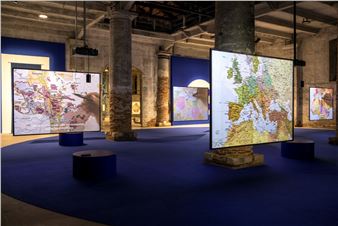Rochelle Rubinstein: Shelter in Place
The block printed banners in SHELTER in PLACE represent Rochelle Rubinstein’s desire to blend the design aesthetics and craft of printmaking on textiles with social and environmental advocacy. When her Open Studio exhibition was postponed due to Covid-19, Rubinstein, using only materials that were already in her studio, reworked some of the banners with messages (such as Shelter in Place, Wash Your Hands, 2 Metres, Flatten the Climate Emergency Curve, Respect Your Mother) and new images (of viruses, red crosses, lungs).
These were layered over older Imagery of plants, hands, hearts, bees, terrorism, keening women, and water. Earlier narratives of nature’s intelligence and fragility, of greed, oppression, and unnatural disasters now blend with Covid-19 narratives and related issues of social upheaval, health systems, environmental destruction, and regenerative agriculture. Rubinstein created the banners on flag material with parades, protests, and rallies in mind. Weatherproof and versatile, even the largest banner can be folded into a small square, ready for use in unusual settings and situations. Several of the banners about water protection have been hoisted at urban and rural parades, at water celebration ceremonies, at protests in front of government buildings and in Ontario barns, as well as in museum exhibitions. The Covid-19 banners have been displayed in empty Toronto storefront windows.

Recommended for you
The block printed banners in SHELTER in PLACE represent Rochelle Rubinstein’s desire to blend the design aesthetics and craft of printmaking on textiles with social and environmental advocacy. When her Open Studio exhibition was postponed due to Covid-19, Rubinstein, using only materials that were already in her studio, reworked some of the banners with messages (such as Shelter in Place, Wash Your Hands, 2 Metres, Flatten the Climate Emergency Curve, Respect Your Mother) and new images (of viruses, red crosses, lungs).
These were layered over older Imagery of plants, hands, hearts, bees, terrorism, keening women, and water. Earlier narratives of nature’s intelligence and fragility, of greed, oppression, and unnatural disasters now blend with Covid-19 narratives and related issues of social upheaval, health systems, environmental destruction, and regenerative agriculture. Rubinstein created the banners on flag material with parades, protests, and rallies in mind. Weatherproof and versatile, even the largest banner can be folded into a small square, ready for use in unusual settings and situations. Several of the banners about water protection have been hoisted at urban and rural parades, at water celebration ceremonies, at protests in front of government buildings and in Ontario barns, as well as in museum exhibitions. The Covid-19 banners have been displayed in empty Toronto storefront windows.
Artists on show
Contact details














